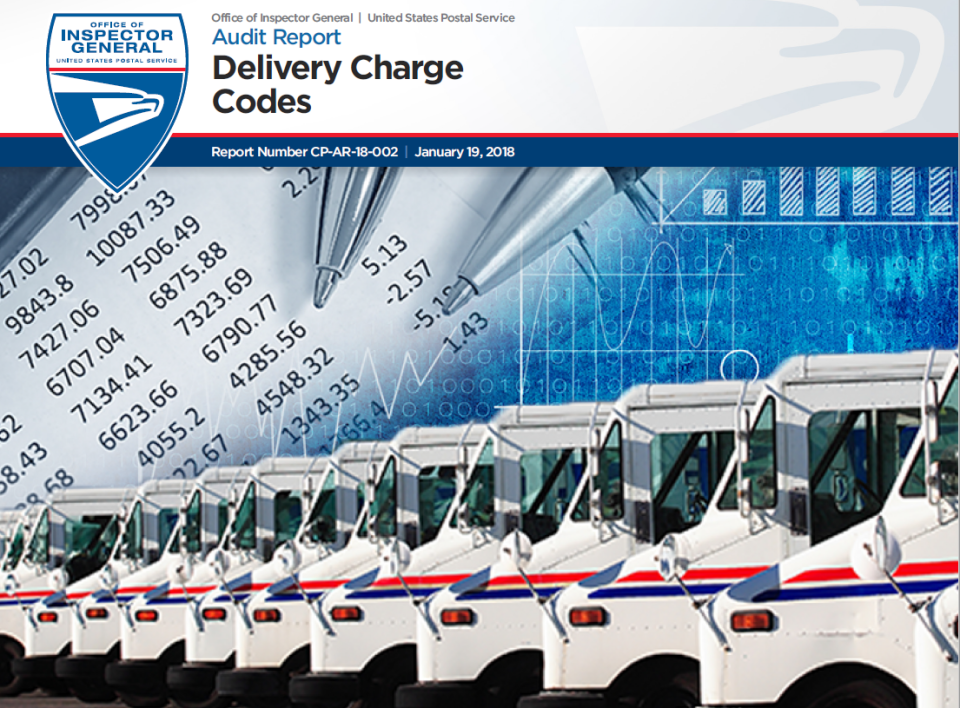Delivery Charge Codes
Objective
The U.S. Postal Service maintains city carrier labor cost data in its Time and Attendance Collection System (TACS). However, this TACS data does not generally associate labor costs with specific mail products and services. Therefore, the Postal Service relies on data from statistical sampling systems, such as the In-Office Cost System (IOCS) and the City Carrier Cost System (CCCS), to determine which city carrier labor costs to allocate to letter routes (normal delivery of letters, parcels, and so on) and special purpose routes (other street delivery activities) as well as which costs to attribute to products and services.Labor distribution codes (LDC) identify the type and hours of work an employee performs. LDCs are aligned with three-digit Management Operating Data System (MODS) operation numbers that further specify a carrier’s current assignment.
On June 30, 2017, the Postal Service submitted a proposal to the Postal Regulatory Commission (PRC) to use more comprehensive data from TACS instead of IOCS sampling data to determine the share of costs for letter routes and special purpose routes (SPR). The Postal Service will still use IOCS and CCCS sampling data to allocate letter route and SPR costs to products and services.
Our objective was to assess the reliability and accuracy of TACS data for city carrier labor costing.
What the OIG Found
The Postal Service could improve the reliability and accuracy of TACS data for use in city carrier labor costing. Specifically:
- Postal Service delivery personnel did not consistently charge Sunday deliverytime to appropriate MODS operation numbers, which resulted in hoursbeing associated with incorrect LDCs. In February 2017, the Postal Servicedesignated a specific LDC for Sunday delivery workhours to more clearlydefine cost pools for Sunday work activities. However, between February andJune 2017, we found personnel inappropriately charged about 67,165 hours(3 percent) of the total universe of Sunday delivery workhours to LDCs other than the Sunday delivery LDC.
This generally occurred because personnel mistakenly charged Sunday workhours to incorrect LDCs. In addition, the new policy was not consistently communicated to employees and delivery supervisors did not always monitor and correct carriers’ clock rings.
This issue did not impact the current city carrier costing methodology because the Postal Service uses sampling instead of LDC workhour data from TACS for city carrier cost attribution. However, under the Postal Service’s proposed methodology to replace IOCS sampling with TACS data to determine the share of costs for letter routes and SPRs, inappropriately charged workhours could impact the accuracy and reliability of total city carrier labor costs allocated to Sunday delivery cost pools and attributed to products and services.
- Delivery personnel did not always maintain documentation supporting clockring adjustments to daily workhours.
- In our review of clock ring data for 160 sampled city carriers and citycarrier assistants at 12 facilities visited, 57 employees had 243 supervisoradjustments that required supporting documentation. However, we couldnot verify whether any of the adjustments were substantiated or justifiedbecause supervisors did not provide the required documentation forthe changes.Supervisors who responded to our inquiry generally cited poor record keeping practices, such as not completing the forms or not retaining them beyond the pay period the adjustment occurred, as reasons for not providing the required documentation.
- Of the total 13,053 workhours logged by the 160 sampled delivery personnel, supervisors changed or moved 2,578 (20 percent) of the hours between different MODS operations without documented justification.
The Postal Service does not require supervisors to document a justification for modifying workhours on an existing clock ring. In addition, TACS does not have controls that require entry of a justification before a supervisor adjustment is accepted.
The ability to adjust clock rings and move workhours between MODS operations without proper justification and oversight increases the risk of improper adjustments. The integrity of workhours associated with the correct MODS operations and LDCs is important so that management has accurate and reliable data to identify, plan, monitor, and control personnel expenses.
In addition, prior audit work found that insufficient controls over clock ring management, such as unsupported changes and noncompliance with policies, increased the Postal Service’s risk of grievances, overtime and penalty overtime payments, and punitive damages.
Further, ineffective controls over clock ring adjustments increases the risk that TACS workhour data is not reflective of actual operational activities. This could impact the accuracy and reliability of cost attribution if the Postal Service proposal to use TACS data in city carrier costing is accepted.
- Potential anomalies were identified in TACS data during this review. Specifically, carriers at 12 facilities visited did not have an end tour clock ring in TACS for about 7 percent (4,965 of 67,492) of the delivery scan records analyzed. This may have occurred because carriers did not clock out at the end of their work day, carriers used an expired time card, or supervisors did not correct carriers’ clock rings. The inability to effectively account for the end of a work day could affect the carriers’ pay and make the Postal Service vulnerable to work claims and legal liability. Furthermore, the reliability of TACS data for city carrier cost attribution would be at risk if the proposed methodology to use TACS data, instead of IOCS data, to determine the share of costs for letter routes and SPRs is approved.
What the OIG Recommended
We recommended management:
- Reiterate the importance of charging workhours to appropriate operation numbers and LDCs.
- Modify TACS to establish controls that flag invalid time codes on Sundays. In the interim, develop a process to monitor the accuracy of clock rings and hold personnel accountable for ensuring Sunday delivery workhours are properly charged.
- Revise Postal Service guidance to require clock ring adjustments to be justified and monitored, and that justifications be maintained.
- Modify TACS to include a field where managers must annotate reasons for making clock ring adjustments.
- Establish automated controls to identify and timely correct missing and incorrect end tour clock rings.

